Can blockchain help in the process of emergency response? How can this type of response be one more resilient, transparent and trustful?
One minute delay increases in 2% mortality rate as we can see in the following graph.
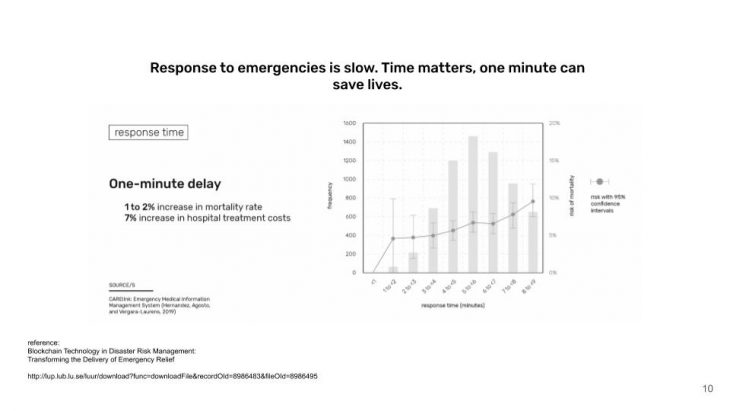
Emergency response time
How can Blockchain shorten this time and act as a collaborative framework for all people involved? How can the issue be approached from a linear protocol to a much more decentralized one where all participants are aware of every change on the chain?
We have taken this course as an opportunity to research the broad range of applications that blockchain can bring to the emergency relief response and also healthcare world.
In essence, two main topics has been approached:
- Disaster resilience and response. This has been studied from the point of view of the different possibilities that it has to offer. How can Blockchain play a pivotal role on how responses are managed and applied in several contexts?
- Emergency response and communication network between different health institutions. In this case a specific scenario has been presented in order to get deep into some of the technicalities and the complex network of institutions that take part in the process.
Disaster resilience and response.
Blockchain can be very present in a Disaster resilience network. These are some of the applications:
- Prediction and forecasting. Extreme weather impact analysis, ledger to identify, verify and transact weather data
- Resilient planning. Enhanced emergency disaster response
- Early-warning systems. Real time monitoring of natural hazards, decentralized weather sensors generating automated alerts.
- Resilient infrastructure. Automatic rerouting of power to prevent blackouts. Decentralized mini-grids improving disaster resilience.
- Financial instruments. Disaster recovery funding. Decentralized disaster insurance platforms. Management of transactions in response to extreme weather events. Crowdsale for adoption investments.
How could we have been benefit from these against a COVID-19 response? What if different organizations worldwide would have been connected through a Blockchain technology that would allow them to keep track of every step and react faster against the outbreak?
Emergency response and communication network.
In a slightly different scale and context, transport and emergency rescue system brings into play a set of different parameters that can make a significant impact into the process. Aspects such as time, which vehicle should go, how many of them, from where or to which hospital seems to be parameters that could be much more interesting if from a blockchain network all parties are aware of the state of each in order to make better decisions.
Let’s imagine the different steps of a case scenario and how this technology could be applied in the different phasing.
Bob is at home, he has signed a Smart Contract that connects some of his IoT (distributed smartly around his home) with the hospital directly if an anomaly is detected.
This would trigger that Smart Contract, which would connect a channel tower and will ask for access to all the different hospitals available which is the best option for Bob. This case scenario could be also something generated on the street/city level, a car accident for instance that through machine learning and image analytics could trigger a Smart Contract so the institution appointed can send help immediately or as we were seeing before a natural hazard that could automate and alert and a reaction.
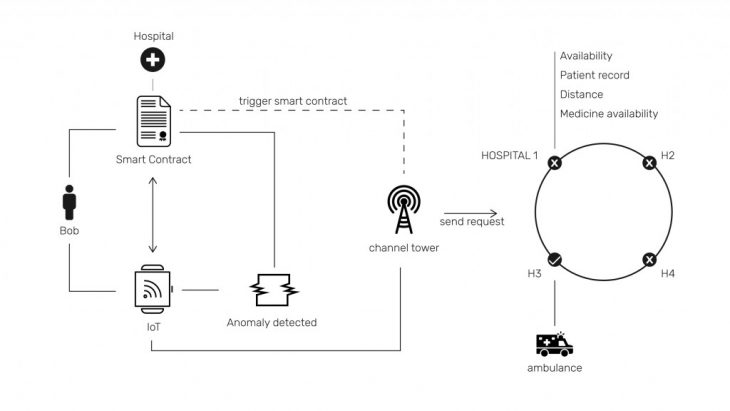
The proposed system (i)
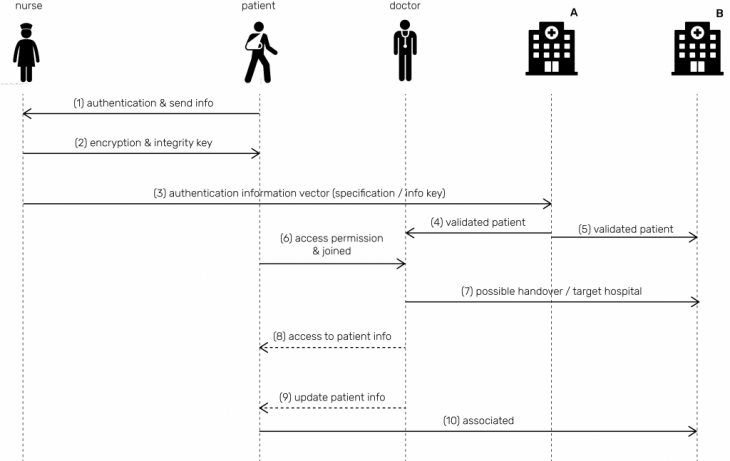
The proposed system (ii)
The idea would be that all these hospitals share information in real time but also predictions about how many patients are expected at what time or Smart Contracts with supply chain companies that will provide with emergency equipment when the hospitals run out of.
An IBM product called “Trust Your Supplier” allows those suppliers to create a trusted, digital identity. The company that first works with the supplier puts them through the usual vetting process, and subsequent companies in the network are able to substantially shorten their due diligence, which saves time and money.
This could have several benefits such as:
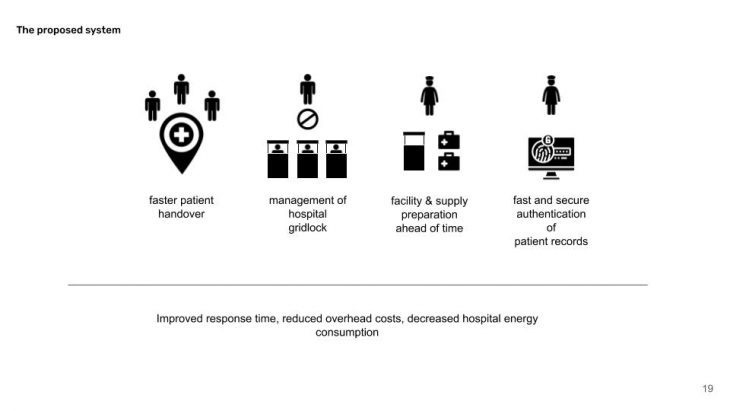 In the following image, taken by a report (image) we can see how times could diminish drastically.
In the following image, taken by a report (image) we can see how times could diminish drastically.
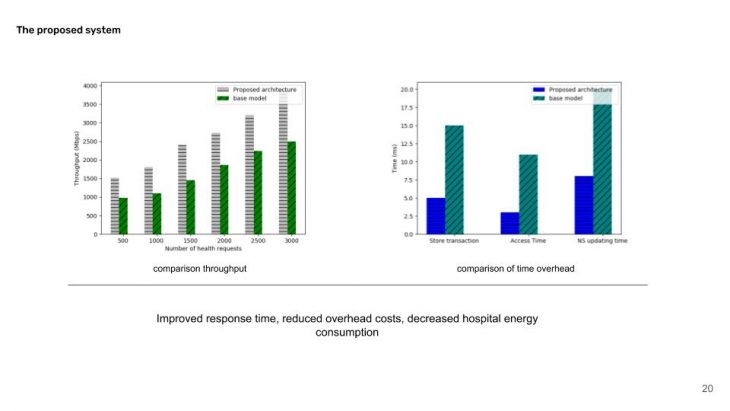 In order to get a better understanding of the technical process, several algorithms to transfer either data, patients or doctors among hospitals has been studied:
In order to get a better understanding of the technical process, several algorithms to transfer either data, patients or doctors among hospitals has been studied:
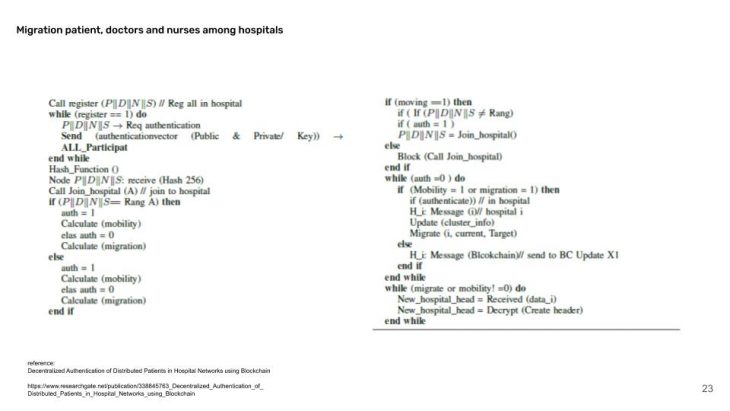
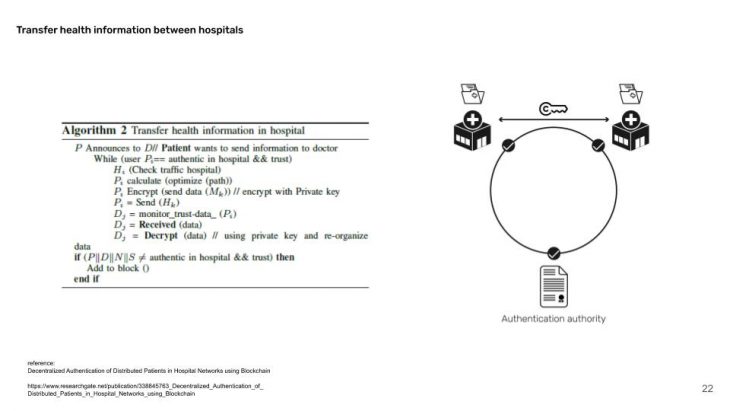
In essence, the benefits in a large scale when talking about Healthcare are the following:

Blockchan main healthcare benefits
As a point of interest to mention during the feedback at the final presentation this network could have the power to bring together private and public hospitals, specially in times of emergency such as the one we have lived and we are living now in order to exchange not just medical equipment but also transferability of health professionals. Universities could be part of this chain as well, allowing recent graduates or professors to be part of this larger emergency response and reaction.
_________________________________
Sources:
- Two-Stage Covering Location Model for Air-Ground Medical Rescue System.
https://www.mdpi.com/2071-1050/11/12/3242
- Blockchain Could Help Hospitals Stay Stocked and Staffed..
https://www.governing.com/next/Blockchain-Could-Help-Hospitals-Stay-Stocked-and-Staffed.html
- Blockchain in Healthcare: A Patient-Centered Model.
https://www.ncbi.nlm.nih.gov/pmc/articles/PMC6764776/
- Role of Blockchain Technology in IoT Applications.
https://www.sciencedirect.com/topics/computer-science/blockchain
- Decentralized Authentication of Distributed Patients in Hospital Networks using Blockchain
- Blockchain to blockchains in life sciences and health care. What broader integration is making possible today. Deloitte
- Smart Ambulance: Blockchain technology in health-care for emergency patients.
https://www.researchgate.net/profile/Nadeem_Javaid/publication/334696607_Smart_Ambulance_Blockchain_technology_in_health-care_for_emergency_patients/links/5d3aa87a299bf1995b4b0ed4/Smart-Ambulance-Blockchain-technology-in-health-care-for-emergency-patients.pdf
- IoT in Healthcare: Smart Beds
https://wyebot.com/2020/03/02/iot-in-healthcare-smart-beds/
- Protecting the Internet of medical things: A situational crime-prevention approach
https://www.cogentoa.com/article/10.1080/2331205X.2018.1513349.pdf
- Impact of Blockchain technology on healthcare sector.
https://www.peerbits.com/blog/blockchain-technology-on-healthcare-industry.html
Blockchain Technology in Emergency Response is a project of IaaC, Institute for Advanced Architecture of Catalonia
Developed at Master in City & Technology in (2019/2020) by:
Students: Rovianne Santiago, Alejandro Quinto, Michelle Rodriguez
Faculty: Jose Muñoz